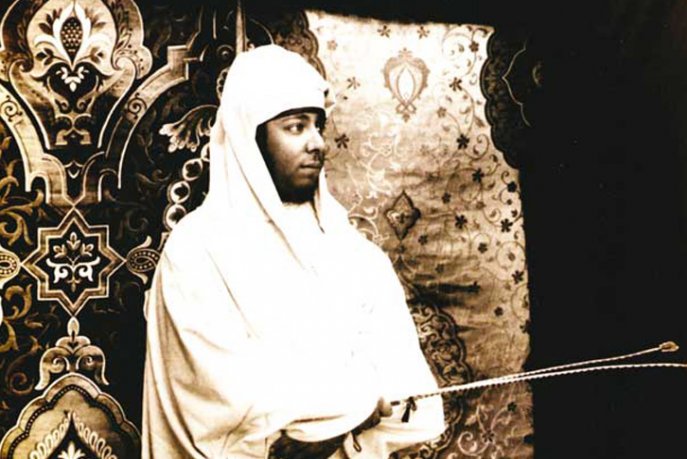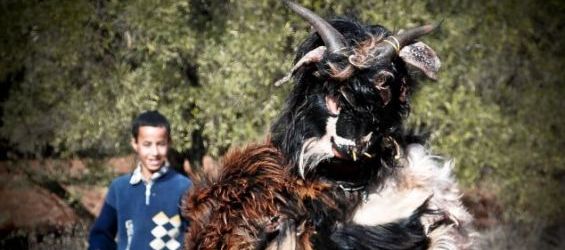Every year, following Eid al-Adha, the Muslim holiday of sacrifice, Morocco witnesses another vibrant festivity. This carnival or parade, often observed between Eid and the Islamic New Year (Hijri New Year) and Ashura (the tenth day of Muharram, the first Islamic month), sees participants adorned in goat skins and masks, taking to the streets.
Known as Bujloud (Arabic) or Bilmawen (Amazigh), meaning «the one with skins, leather, or pelts», this tradition involves young Moroccans parading and dancing in costumes meticulously crafted each year from animal skins, horns, and even limbs from sacrificed Eid animals. Photos and videos of these elaborate, Halloween-inspired costumes, often featuring colorful wigs, eerie eye lenses, and even 3D makeup, flood social media.
However, Bujloud isn't without its critics. Some view the yearly tradition as controversial. Pan-Arabists consider it a pagan practice «foreign» to Moroccan culture, while Islamists associate it with «satanism», denouncing its timing after a major Islamic holiday.
A deep-rooted tradition
Bujloud, however, runs deep in Moroccan history, reflecting the practices, beliefs, and social interactions of its ancestors. Moroccan anthropologist Abdellah Hammoudi notes its presence in Morocco for centuries, first documented by the late 19th century.
Hammoudi, in his book «The Victim and Masks: An Essay on Sacrifice and Masquerade in the Maghreb», highlights how Bujloud captured the attention of foreign observers, particularly the French, during this period. He notes that Arabs, on the other hand, rarely acknowledged festivals outside the official Islamic calendar.
Early descriptions of Bujloud, therefore, come primarily from «outsiders», argues Hammoudi. He emphasizes that masquerades like Bujloud were practiced throughout Morocco, from the Atlas Mountains to the north among Jbala and Rif tribes, and in cities like Marrakech and Fez. Accounts from foreign researchers and ethnographers document the variations in the tradition across regions and tribes.

Interestingly, Bujloud even reached the royal court, becoming a common feature during Ashura celebrations. As Hammoudi notes, French anthropologist Edmond Doutté documented Bujloud appearing «in the streets the morning after the sacrifice» in Marrakech in 1907.
According to French diplomat Eugene Aubin (relayed by Hammoudi), Bujloud continued throughout the period following Eid in Marrakech, culminating in open-air masquerades during Ashura. Aubin describes Bujloud in Marrakech as «Herrema Bu Jlud», a tradition known for its comedic performances, especially before the sultan.
«This custom is highly developed, and some real comic gems are performed», wrote Aubin, emphasizing their presence «particularly before the sultan». He details performances featuring a Qadi (judge) and a «burlesque» trial, with the highlight being the «mockery» of the European ambassador, his interpreters, and especially the ministers.

The ministers, though uncomfortable being ridiculed, had to «put a good face on it» as the sultan and their colleagues roared with laughter. A similar spectacle called «fraja» ('the great entertainment') was also performed before the sultan in Fez on the occasion of Ashura. Hammoudi cites Doutté's account of the same spectacle occurring in 1907 not only at the sultan's court but also at the court of the pretender Bu Hmara, who challenged the reigning dynasty.
This inclusion of Bujloud in royal celebrations underscores its deep roots in Moroccan culture, enjoyed by the sultan himself.
Fusion and transformation
Beyond the royal court, anthropologists view Bujloud as an example of Moroccans blending old traditions with Muslim festivities. Hammoudi explains that the timing, falling between the sacrifice and the New Year, signifies a temporal transition. He points out that most observers interpret these festivals as «ancient pagan ceremonies for the renewal of nature» integrated into the Muslim calendar.
While the symbols and elements might suggest a connection to past traditions, Hammoudi argues that such blending of religious and cultural practices is common across cultures. However, the French North African school's focus on «survivals» implying a clear separation between pagan and Muslim festivals is problematic.

This approach, even when acknowledging connections, downplays the unique meaning of Muslim festivals by forcing comparisons with supposed pagan origins. It not only ignores the individual significance of each festival but also misses the deeper meaning created by their coexistence within the rituals, argues Hammoudi.
Symbolic interpretations
Other ethnographers offer various interpretations of Bilmawen (the Amazigh name for Bujloud). Hammoudi cites Laoust's hypothesis, comparing Bilmawen to the Roman god Lupercus, a protector of farmers and harvests against wild animals. Laoust suggests Bilmawen takes on the role of a scapegoat, absorbing evil spirits through the act of touching participants. Another interpretation sees Bilmawen as an embodiment of an ageing god, sacrificed and revived through a vigorous animal.
Hammoudi connects this symbolism to the sacrifice during Eid al-Adha, suggesting the Islamic holiday might have adopted an older Berber festival that began with a sacrifice. He argues that the new festival might be seen as a continuation of the old, possibly disguised by Christian and then Islamic traditions.

Beyond its symbolic interpretations, Bujloud also serves as a platform to challenge social norms. The masquerades become a space to temporarily invert the rules of everyday life. Hammoudi suggests they represent a «secondary foundation for civilization roles», with Bilmawen embodying the necessary chaos that complements social order. He argues that masquerades highlight generational hierarchies, with youth challenging elders in a blend of initiation rite and social protest. Bujloud amplifies themes of sexuality, procreation, and power dynamics through its playful performances.
Despite facing criticism, Bujloud remains a vibrant tradition in Morocco. It's a complex celebration that blends elements of history, religion, and social commentary. The colorful costumes, lively performances, and playful chaos of Bujloud continue to capture the imagination of Moroccans, both young and old. Whether seen as a continuation of ancient traditions, a platform for social critique, or simply a joyous celebration, Bujloud endures as a testament to Morocco's rich cultural heritage.




 chargement...
chargement...












